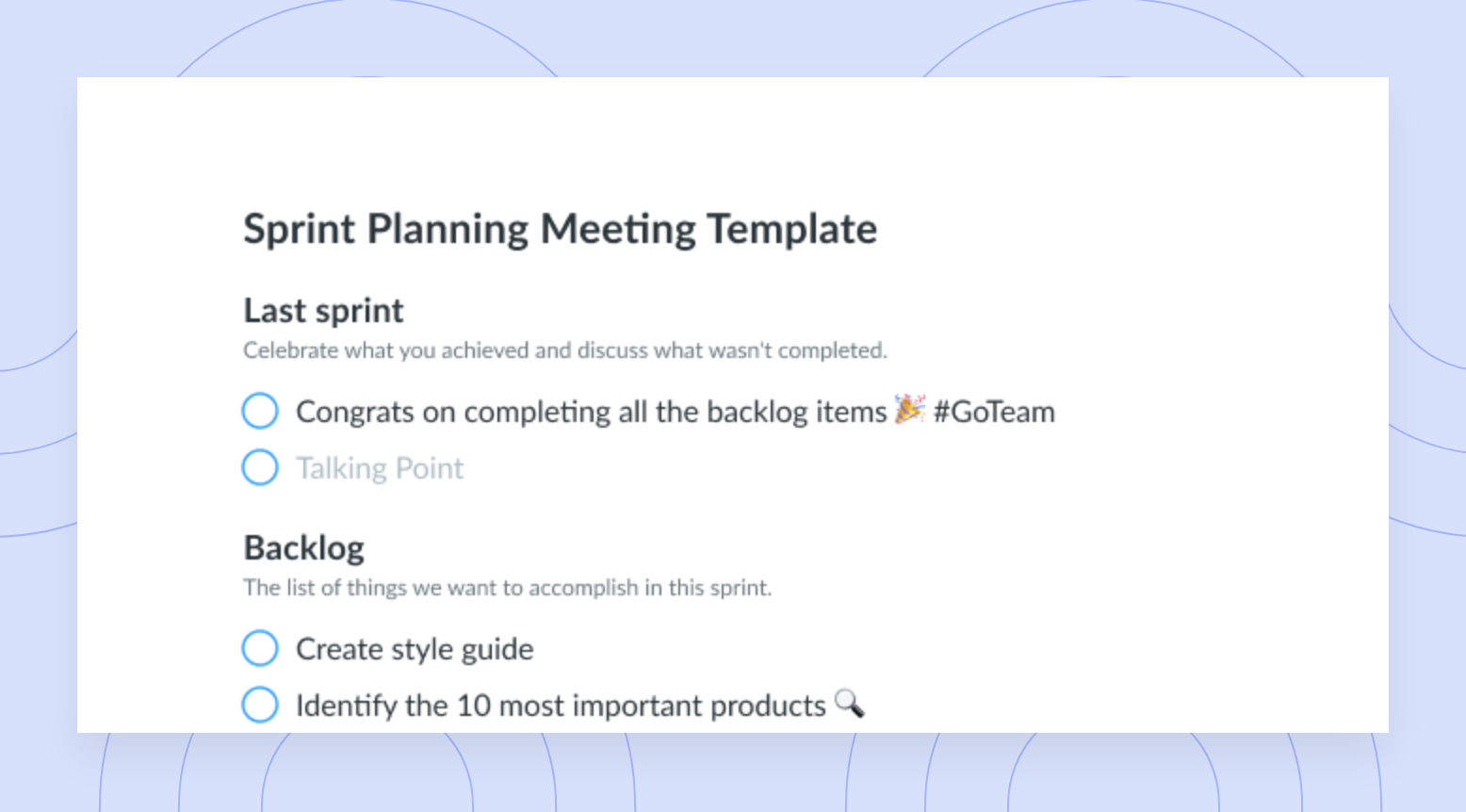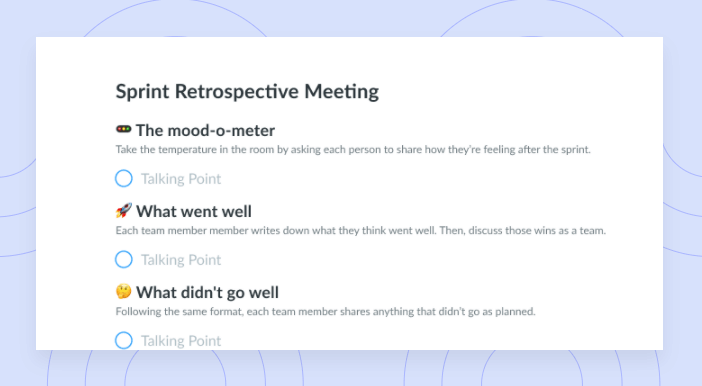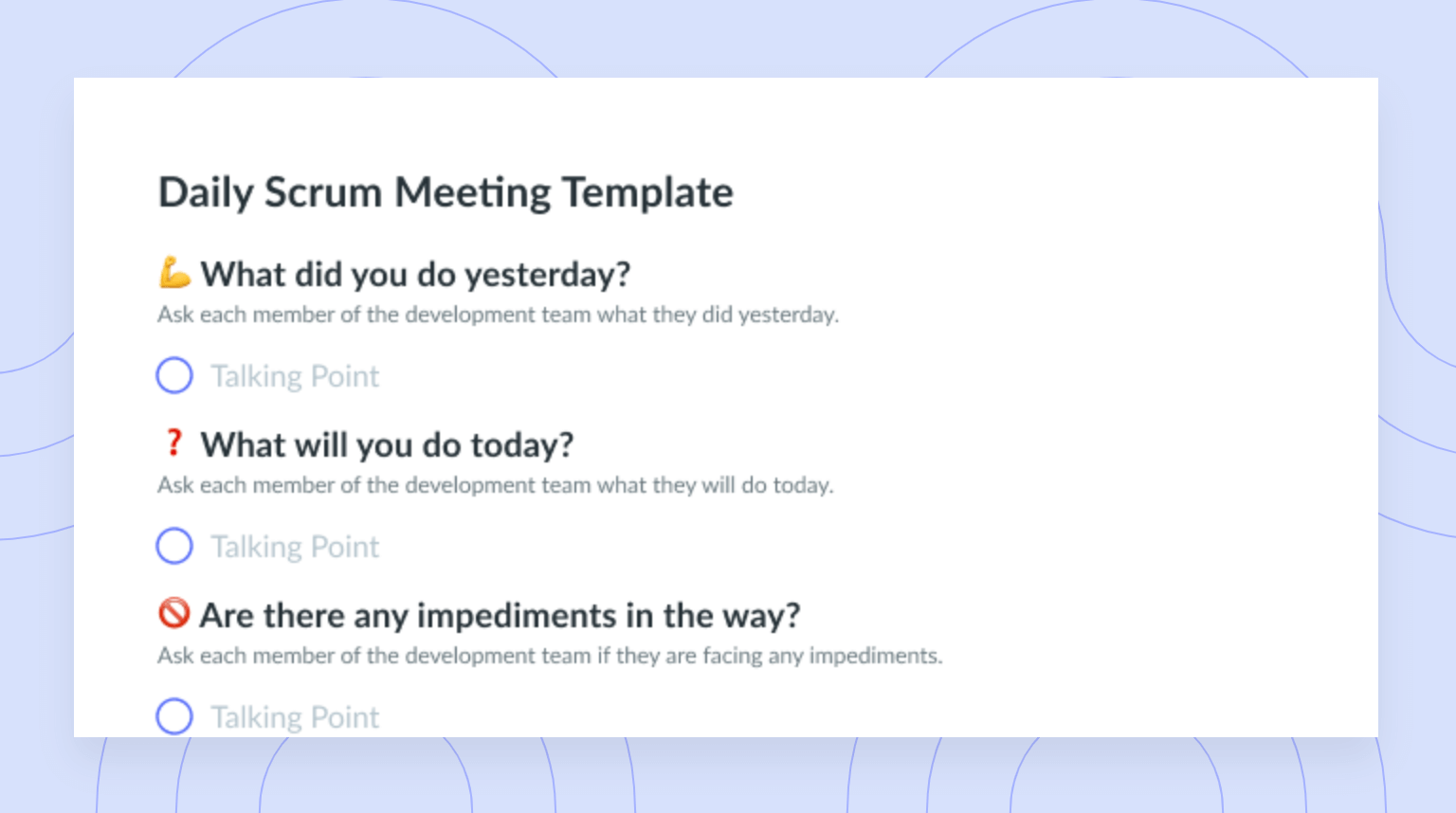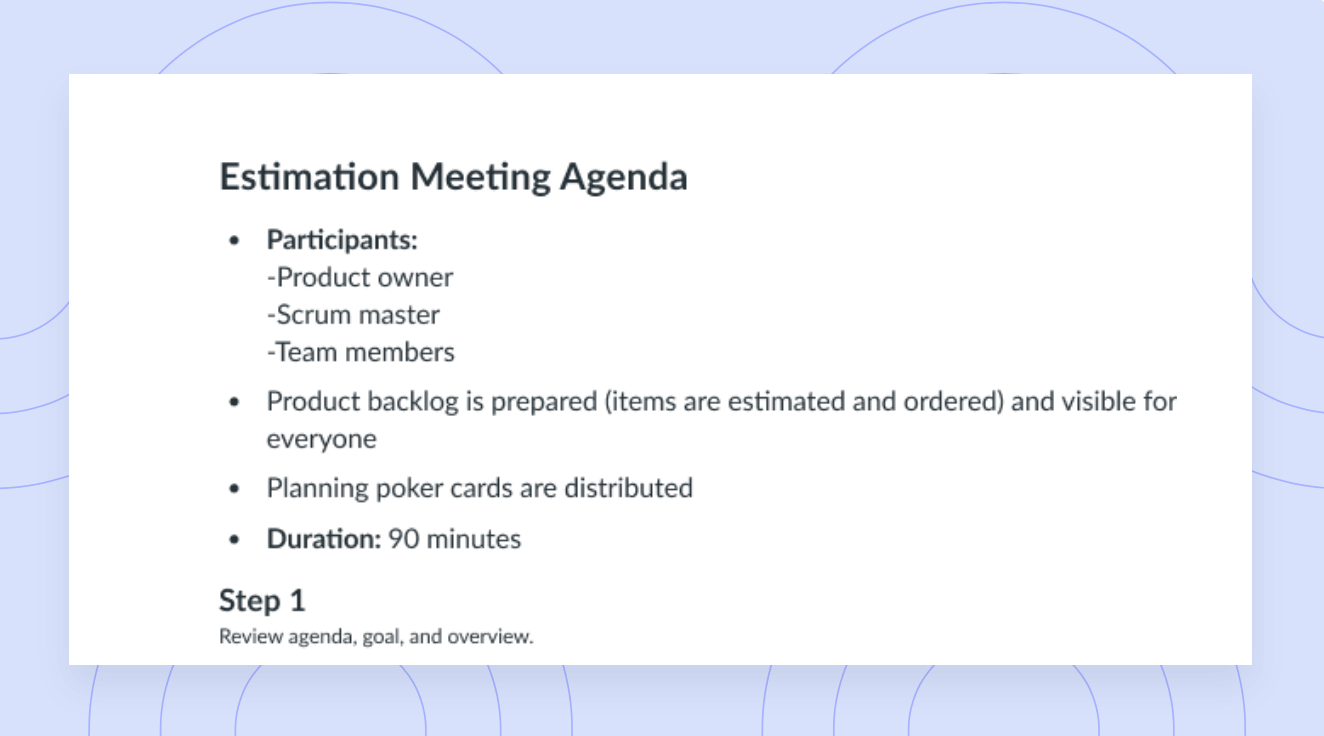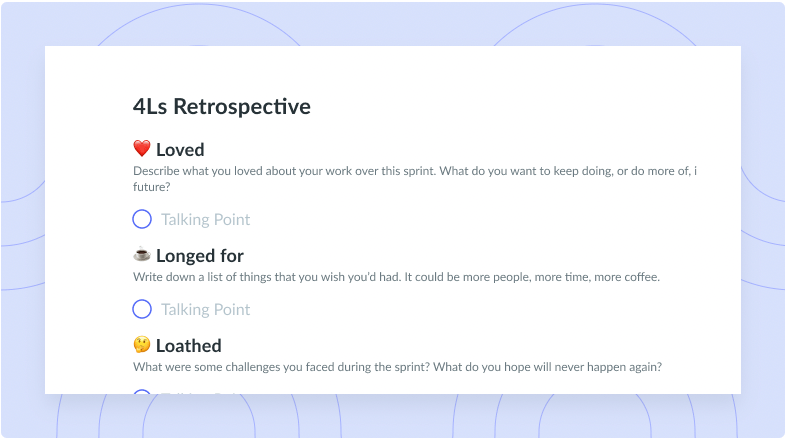Scrum Meetings: Types, Benefits, and Tips to Get It Done Right
Before you dive into a new project, stop and scrum! Here are all the details on running an effective scrum.
When a new project or assignment is given to your team, you may be so excited that you just want to roll up your sleeves and dive right in.
But before you do, it’s important that you take the time to meet with your team, get synced with everyone’s responsibilities, and ensure the group is on the same page regarding goals. To do this effectively, you’re going to need to hold a scrum meeting first.
If you’re new to the world of scrum meetings, you’re not alone. Fellow is here to help provide a guide to ensure your scrums are a smashing success.
- What is a Scrum Meeting?
- Types of Scrum Meetings
- The benefits of Scrum Meetings
- Master these tips for your next Scrum Meeting
- Scrum meeting agenda examples
What is a Scrum Meeting?
A scrum meeting, sometimes referred to as a daily stand-up, is a quick check-in with your team or a specific group of people within an organization. They typically occur once a day, usually in the morning, and are generally no more than 15 minutes in length.
Attending a scrum meeting, you’ll find:
- The scrum master, someone who’s the team’s facilitator or point person
- The product owner, someone who’s the project manager or management lead
- The development team, the group working on a project or assignment
The goal of a scrum meeting is for key stakeholders, management, and team members to come together to ensure everyone is aligned regarding each step of a specific project.
Types of Scrum Meetings
Your team can decide to partake in various types of scrum meetings, which are commonly referred to as scrum ceremonies. There are five main types of scrum meetings, which one you hold will depend on your product stage.
1 Daily Scrum
A daily scrum meeting, or a daily standup meeting, takes place… you guessed it… every day!
This type of scrum gives the team a chance to review goals, where they are within the project timeline, and any potential bottlenecks or blockers they may be experiencing.
They take place at the same time every day and are done while everyone is standing up. They usually take place in the morning but can be scheduled for any part of the day, as long as they remain consistent.
In a daily scrum, questions are usually laid out ahead of time to be answered, so everyone can come prepared with their own individual answer. These questions are typically:
- What did you accomplish yesterday?
- What are you hoping to accomplish today?
- Is there anything blocking you from getting your to-do list completed?
- How close are you to hitting your goals?
- Is there anything you need from the team?
Answers to these questions assist the scrum master in getting a sense of everyone’s progress and how likely the team is to achieve the various milestones they have throughout the project timeline. They also help the team get a comprehensive look at what everyone is working on and help relieve anyone’s bottleneck.

Pro tip
Use a meeting management tool like Fellow to prepare a meeting agenda before each scrum meeting to ensure the right questions are being asked and all answers are documented in one place.
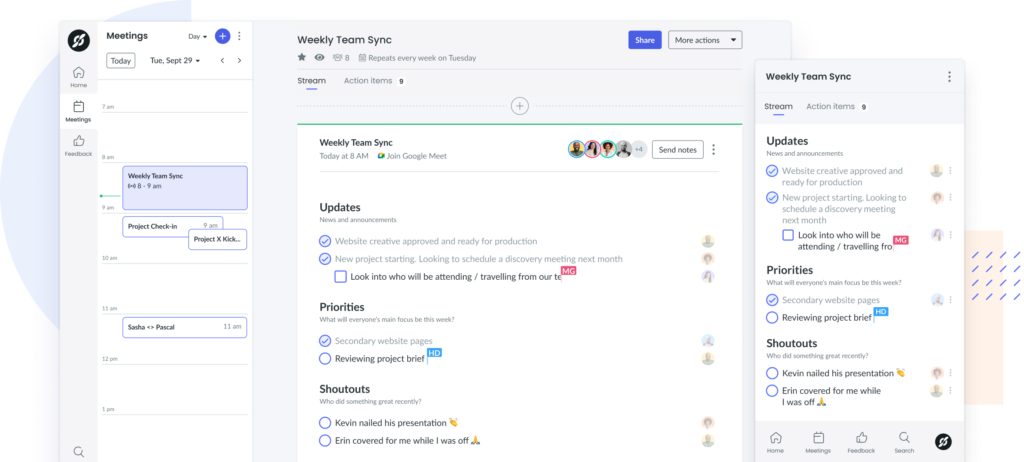
2 Sprint Planning
Next up are sprint planning meetings. In these meetings, the goal is to set up the scrum teams for success throughout the sprint. The product owner, the scrum master, and the entire scrum team will attend a sprint planning.
Here, the team will review the backlog of projects and narrow down what they’d like to prioritize for the next sprint. Each task will also be assigned a sprint team member. This type of scrum meeting aims to ensure that everyone involved is on the same page before the work begins.
At the end of the sprint planning session, the team should have two items:
- A sprint goal, which will consist of a summary of the plan for the next sprint
- A sprint backlog, which is the list of projects or assignments the team will work on during the sprint
At the end of the planning meeting, every scrum team member needs to be clear on what can be delivered in the sprint and how it’ll be accomplished. Everyone involved must agree on the work chosen for the next sprint.
3 Sprint Retrospective
A sprint retrospective is a discussion or conversation that takes place after the sprint has come to a close. The team will come together to review what happened during the sprint, including:
- What worked well
- What didn’t go as planned
- What can be improved for the next sprint
The whole team is in attendance during a sprint retrospective, and these meetings should only take about an hour in time. Even if the previous sprint was a smashing success, there’s always room for improvement, and how to improve will be discussed in a retrospective. Once everyone has contributed an idea or two for how to improve, the team may choose to vote on specific points to focus on next time.
4 Backlog Refinement
Backlog refinement meetings are sometimes referred to as backlog grooming meetings, as they are used to discuss projects or assignments within the backlog. The backlog will usually consist of upcoming items or projects that need to be completed by the team.
The goal of backlog refinement is to keep this running list as accurate and as up-to-date as possible, along with as many details the team can get their hands on. This list will be referred to in upcoming sprints when deciding which direction to go in next.
5 Sprint Review
Finally, there’s the sprint review, which will take a deep dive into the actual end result, or product produced, at the end of the sprint. The scrum team comes together to show off what was accomplished and will usually demo its features and functionality. In addition to the team, attendees can also include upper management, customers, or developers working on other products.
The final product will also be compared up against the original goals of the sprint to see if they match up.
The benefits of Scrum Meetings
So, why hold any of these scrum meetings in the first place? There are many benefits to doing so. Because scrum teams work under short and specific deadlines, having regular scrums ensures everyone is always on the same page and that bottlenecks can be spotted and solved fast.
Some other scrum meeting benefits are:
- Help the team identify obstacles before they become too severe
- Allow the group to reflect on all of their hard work once the product is complete
- Provide ways to better improve on processes for new sprints
- Give scrum team members an understanding of the responsibilities they’ll have during the next sprint
Master these tips for your next Scrum Meeting
In order to hold the most successful scrum meeting possible, be sure to master these tips for maximum productivity and efficiency.
- Define a clear purpose
- Stick to the agenda
- Always be iterating
- Keep the Sprint Goal in mind
- Own the Scrum Master role
- Stick to the time frame
1 Define a clear purpose
If you want to ensure your scrum meetings stay on-task and remain productive, make sure to set a clear objective ahead of time. Before everyone comes together to meet, specify the type of scrum meeting that will take place and how long the meeting will last.
2 Stick to the agenda
A super easy tip to follow is to create and stick to a meeting agenda. Preparing an agenda ahead of a meeting, and sending it out to all attendees, is an absolute must – no matter what type of meeting you’re holding.
Doing so ensures that everyone can prepare ahead of time with talking points, concerns, or questions for the team.
3 Always be iterating
There’s always room for improvement – even the most successful projects usually have something scrum members wish they could have done differently. It’s okay to be a perfectionist in scrum meetings and always strive for better results next time.
4 Keep the Sprint Goal in mind
It’s crucial that everyone involved in the sprint is aligned with the goal they’re working towards. During sprints, especially daily scrums, every team member should be sharing how they’re contributing to the end goal. Getting these regular updates ensures that the goal is front and center and provides a bigger picture of the likelihood of achieving this goal as a team.
5 Own the Scrum Master role
Just like the most successful meetings have an established meeting facilitator, the best scrums have a scrum master who owns their role. The scrum master is the team’s coach who helps everyone perform at their highest level. It’s up to them to ensure the team remains focused during the sprint on the goal they agreed upon from the start.
6 Stick to the time frame
No one likes a meeting that runs long, especially scrum meetings. It’s important to clearly define how long each scrum meeting will last so they don’t bleed into valuable time the team could be spending on their actual assignment for the day.
Be sure your team knows how crucial it is to show up on time and arrive prepared. If people are showing up late, don’t wait for them to arrive – start without them.
Scrum meeting agenda examples
Daily Scrum
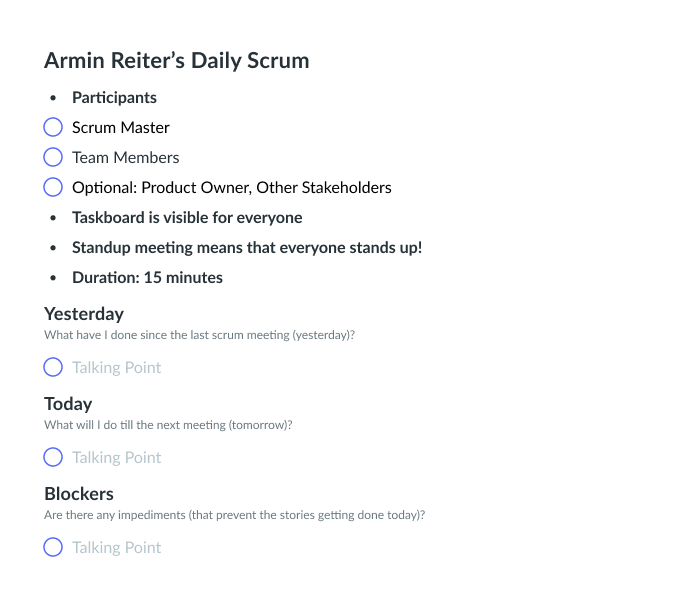
Spring planning

Sprint retrospective
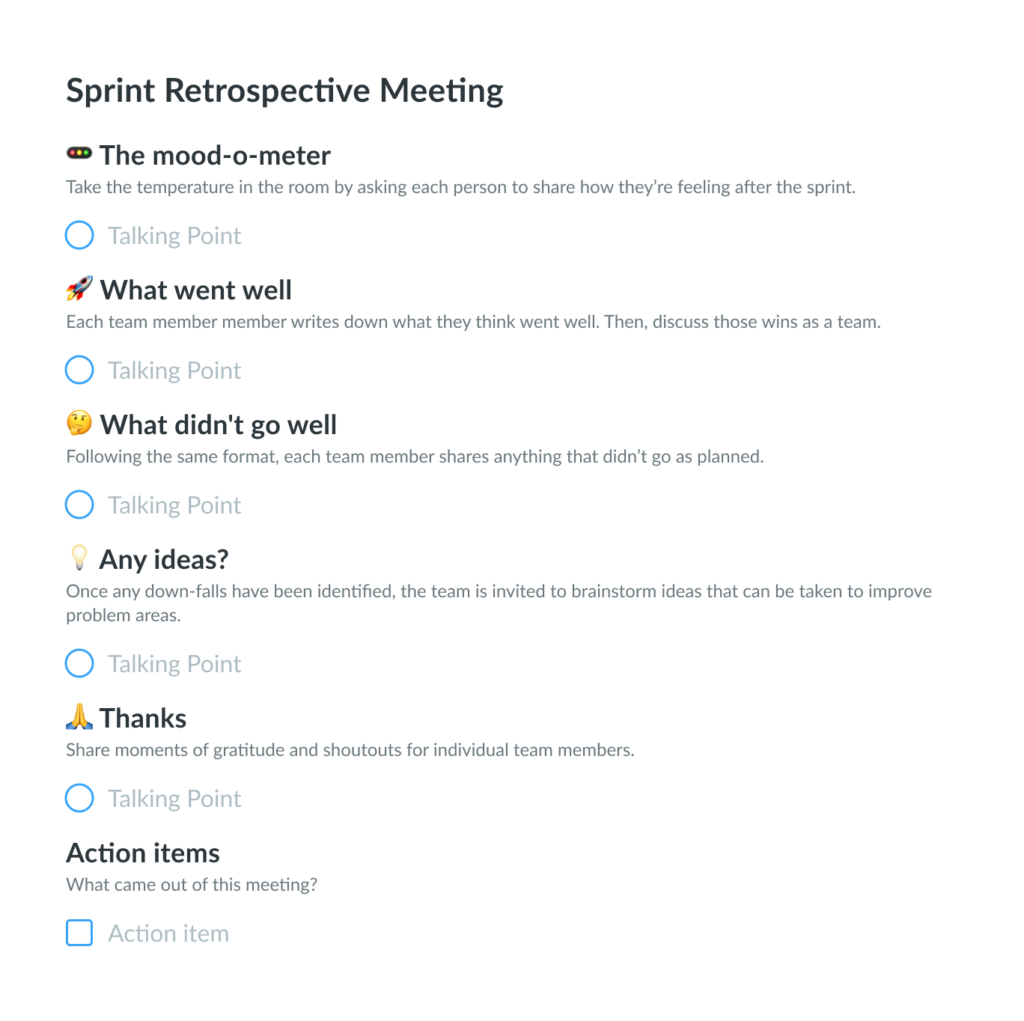
A scrum for everyone
Before you dive headfirst into building something new, first stop and scrum. No matter what your team is in charge of creating, you want to make sure the process from start to finish is as efficient as possible. Holding scrum meetings with a fully built-out agenda, asking the right questions, and working as a team to get the job done will get you there.

![Software Engineering Scrum Meetings 101 [+ Free Templates]](https://fellow.app/wp-content/uploads/2022/07/Software-Engineering-Scrum-Meetings.jpg)







